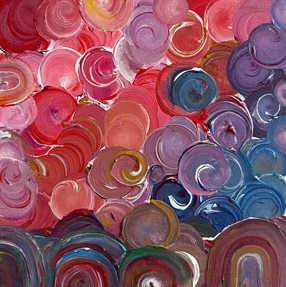Colours of unity
Reflection

Using a variety of colours and brush strokes, this painting aims to illustrate the importance of embracing our unique identities and values while recognising the diversity in others. Each colour and pattern represents a particular aspect of an individual's identity, such as culture, ethnicity, religion, and personality. By combining these colours and strokes, the painting represents the unity and sense of belonging that is created when we embrace diversity within the wider community. This artwork reflects the interconnectedness of all individuals, highlighting that we are all part of a collective whole.
Creating a safe and inclusive environment that cultivates a sense of belonging for all patients is crucial in healthcare. To achieve this, it starts with primary care education by teaching students to learn, recognise, and appreciate the diversity that exists. This can be achieved by taking the time to understand the unique backgrounds and experiences of the patients that students are exposed to early on. It also requires reflection on one's own biases and assumptions. Patients must feel heard without judgment to be able to develop a deeper understanding of their needs and concerns, which ultimately leads to better outcomes in their care. Ensuring dignity in care also involves guaranteeing a safe space and privacy during examinations, providing care that maintains an individual's self-respect, and avoiding actions that may undermine them. For instance, treating patients with respect and autonomy, while taking into consideration their cultural beliefs and values in the care provided, acknowledges their individuality and promotes patient centred care, thereby upholding their dignity.
Another interpretation of this painting is that it can also represent the different communities that exist in our society, which share commonalities while highlighting their unique differences. In relation to justice, it is essential to recognise that discrimination still exists in clinical practice, as some minorities still experience prejudice based on the colour of their skin (1). It is crucial to recognise the impact of cultural competence and awareness of healthcare disparities and actively work towards enhancing it through education to overcome these barriers. A lack of awareness can result in unconscious bias and perpetuate inequities in access and quality of care, as seen in racial disparities in pain management (2). Cultural competence can be developed through exposure to understanding of the various cultural, social determinants, economic factors, and addressing healthcare disparities that affect the health of patients from different racial and ethnic backgrounds. Being taught on ethics and professionalism can help guide medical practice on the principles of justice, fairness, and respect for patient autonomy. Ultimately, to overcome these barriers, students should learn how to advocate for their patients and work towards creating a more just healthcare system. The colours of unity serve as a reminder of the interconnectedness of all individuals and the importance of embracing diversity and recognising the different communities of our society.